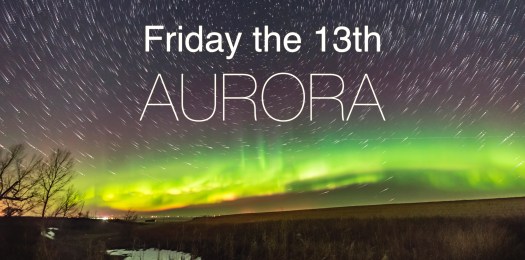
October has brought clear skies and some fine celestial sights. Here’s a potpourri of what was up from home.
We’ve enjoyed some lovely early autumn weather here in southern Alberta, providing great opportunities to see and shoot a series of astronomical events.
Conjunctions
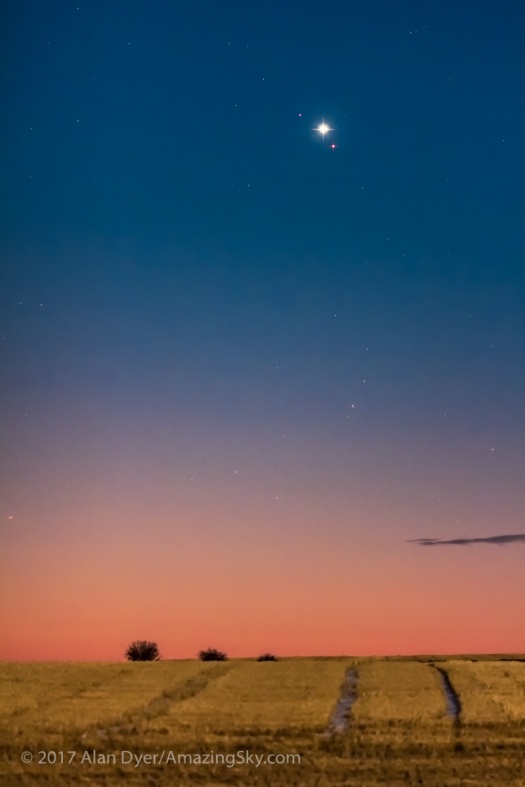
On October 5, Venus and Mars appeared a fraction of a degree apart in the dawn twilight. Venus is the brightest object, just above dimmer but red Mars. This was one of the closest planet conjunctions of 2017. Mars will appear much brighter in July and August 2018 when it makes its closest approach to Earth since 2003.
Satellites: The Space Station
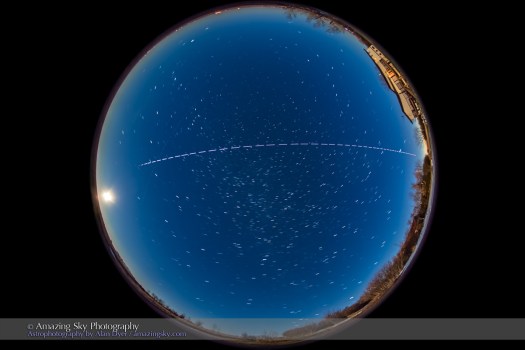
The Space Station made a series of ideal evening passes in early October, flying right overhead from my site at latitude 51° N. I captured it in a series of stacked still images, so it appears as a dashed line across the sky. In reality it looks like a very bright star, outshining any other natural star. Here, it appears to fly toward the rising Moon.
Satellites: Iridiums
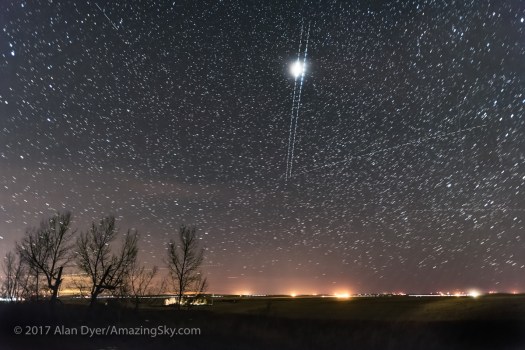
Often appearing brighter than even the ISS, Iridium satellite flares can blaze brighter than even Venus at its best. One did so here, above, in another time-lapse of a pair of Iridium satellites that traveled in parallel and flared at almost the same time. But the orientation of the reflective antennas that create these flares must have been better on the left Iridium as it really shot up in brilliance for a few seconds.
Auroras
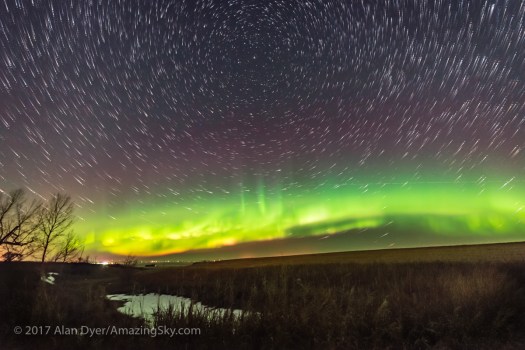
Little in the sky beats a fine aurora display and we’ve had several of late, despite the Sun being spotless and nearing a low ebb in its activity. The above shot is a composite stack of 200 images, showing the stars circling the celestial pole above the main auroral arc, and taken on Friday the 13th.

This frame, from some 1300 I shot this night, October 13, captures the main auroral arc and a diffuse patch of green above that pulsed on and off.
You can see the time-lapse here in my short music video on Vimeo.
Friday the 13th Aurora from Alan Dyer on Vimeo.It’s in 4K if your monitor and computer are capable. It nicely shows the development of the aurora this night, from a quiescent arc, through a brief sub-storm outburst, then into pulsing and flickering patches. Enjoy!
What all these scenes have in common is that they were all shot from home, in my backyard. It is wonderful to live in a rural area and to be able to step outside and see these sites easily by just looking up!
— Alan, October 16, 2017 / © 2017 Alan Dyer / AmazingSky.com


The Iridium flares will no longer be visible by the end of 2018, so catch as many as you can. SpaceX is launching another 10 replacement sv’s in a few weeks to break the 1/2 way point for Iridium constellation upgrade. The pass you saw/photographed could have been two block 1 satellites flying tandem to compensate for aging components. Rare scenario.
Hi Alan. I really enjoy your beautiful pictures! I am from the Midwest having been born and grown up in Indiana where my older brother and I would spend many hours looking thru his telescope where he taught me the names of the constellations and planets. I also lived in Iowa for many years and now live in Bellingham, WA, near the San Juan Islands. Nights are usually cloudy here on the coast and your pictures of the big wide clear skies at night in Alberta bring back happy memories of the big wide clear skies in the Midwest. Thank you for sharing the beauty of nature with others! Marla Johnson
Thank you for sharing, Alan.You are blessed to have that amazing sky in your own backyard. I never understood how sad light pollution is until I visited Churchill and took my very first photograph of the night sky. Here in the suburbs of Chicago, even on a clear night, I’m lucky to see any stars at all 😦
~Lenore
Hi! Looks like my Feb sessions at CNSC are sold out already! I hope the weather is cold and clear, unlike last January’s first group when the weather was unusually warm but cloudy. The first clouded out group in many many years,